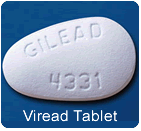| Tenofovir
(Viread) for Patients with HIV-HBV Coinfection By
Liz Highleyman  Tenofovir
(Viread) is a nucleotide analog with activity against both HIV
and hepatitis B virus (HBV). It is one of the
most commonly prescribed antiretroviral
drugs -- included in both the Truvada
and Atripla fixed-dose combination
pills -- and was approved in August as an anti-HBV
treatment. Tenofovir
(Viread) is a nucleotide analog with activity against both HIV
and hepatitis B virus (HBV). It is one of the
most commonly prescribed antiretroviral
drugs -- included in both the Truvada
and Atripla fixed-dose combination
pills -- and was approved in August as an anti-HBV
treatment.
Given its dual activity, tenofovir has particular potential
benefit for HIV/HBV coinfected individuals.
Several studies of tenofovir in this population were presented at the recent 59th
Annual Meeting of the American Association for the Study of Liver Diseases (AASLD
2008) in San Francisco.
2
Thai Studies G.
Matthews and colleagues presented data from 2 studies of tenofovir-based HAART
in antiretroviral-naive HIV/HBV coinfected patients in Thailand, most of whom
had advanced HIV disease (median CD4 count 42 cells/mm3; 45% with a prior AIDS
diagnosis). In the TICO trial, 36 participants were randomly assigned to receive
zidovudine/lamivudine, zidovudine/tenofovir, or tenofovir/lamivudine, while in
the HIV NAT 023 trial, 18 participants received zidovudine/emtricitabine or tenofovir/emtricitabine.
Like tenofovir, lamivudine (3TC;
Epivir) and emtricitabine (Emtriva)
are also active against both HIV and HBV. All patients also received efavirenz
(Sustiva). After
the primary endpoint of HIV suppression was assessed at 48 weeks, participants
continued follow-up in an HIV-HBV cohort study. Those who were receiving lamivudine
or emtricitabine as their sole anti-HBV agent added tenofovir. At
the last follow-up, a median of 27 months after HAART initiation, patients had
been on tenofovir-containing regimens for a median of 8 to 32 months, depending
on which study arm they started in. All patients had HIV RNA suppression <
50 copies/mL and the median CD4 count was > 300 cells/mm3. 72% had HBV DNA
< 20 IU/mL (94% < 400 IU/mL; 100% < 1000 IU/mL). Hepatitis B "e"
antigen loss occurred in 46% of initially HBeAg positive patients, and 33% experienced
HBe seroconversion. The
investigators concluded that "[Tenofovir]-containing HAART is highly successful
in achieving HIV and HBV-related virological suppression in coinfected subjects
initiating HAART in Thailand, irrespective of regimen."
National
Centre in HIV Epidemiology and Clinical Research, University of New South Wales,
Sydney, NSW, Australia; HIV-NAT , Thai Red Cross AIDS Research Centre, Bangkok,
Thailand; Vaccine and Cellular Immunology Laboratory, Chulongkorn Hospital, Bangkok,
Thailand; Infectious Diseases Unit, Alfred Hospital, Melbourne, Victoria, Australia;
Department of Medicine, Monash University, Melbourne, Victoria, Australia; Royal
Melbourne Hospital, Melbourne, Victoria, Australia; John Hopkins University, Baltimore,
MD; Victorian Infectious Diseases Reference Laboratory, Melbourne, Victoria, Australia.
Combination Therapy
Like
HIV, HBV can develop resistance to drugs
used as monotherapy, potentially limiting long-term efficacy. O. Lada and
colleagues retrospectively compared outcomes in HIV/HBV coinfected French patients
who started therapy with 1 or 2 agents with anti-HBV activity. Among a subgroup
of 61 patients with baseline HBV DNA > 3 log IU/mL, 15 started a regimen that
included tenofovir plus either lamivudine
or emtricitabine at the same time, while 46 added tenofovir to a regimen that
already included lamivudine or
emtricitabine.
All patients starting a combination anti-HBV regimen achieved early HBV
viral load suppression at 6 months, compared with 75% who subsequently added tenofovir.
However, all patients with good adherence in the tenofovir add-on group ultimately
achieved delayed HBV suppression after a median of 20 months. As expected, patients
in the tenofovir add-on group were more likely to have lamivudine resistance mutations
at baseline (46% vs 11%).
The investigators concluded, "In our cohort
of HIV/HBV coinfected patients de novo
combination therapy appears to lead to an earlier virologic response than add-on
therapy," and recommended that "De novo combination therapy should be
considered in HIV/HBV coinfected patients."
Service d'Hépatologie
and INSERM U773, AP-HP Hôpital Beaujon, CRB3, Clichy, France; Service des
Maladies Infectieuses, AP-HP Hôpital Bichat Claude Bernard, Paris, France;
Service de Virologie, AP-HP Hôpital Bichat Claude Bernard, Paris, France;
Service de Pharmacie Clinique, AP-HP Hôpital Bichat Claude Bernard, Paris,
France.
A Spanish team also confirmed the benefits of starting with
combination anti-HBV therapy. P. Tuma and colleagues conducted a retrospective
analysis of HBV DNA in HIV/HBV coinfected patients receiving tenofovir plus lamivudine
plus a third antiretroviral agent. Nine patients started tenofovir and lamivudine
simultaneously, while 47 had prior lamivudine experience.
After 48 weeks
of therapy, 49 patients (88%) had undetectable HBV DNA, which did not differ significantly
according to prior use of lamivudine. However, those who started tenofovir and
lamivudine together achieved HBV suppression in 35 weeks on average, compared
with 74 weeks for those with prior lamivudine failure.
"Dual therapy
with [tenofovir plus lamivudine] provides serum HBV DNA suppression in a large
proportion of HIV/HBV coinfected patients," the researchers concluded.
However,
they continued, "time to achievement of undetectable serum HBV DNA levels
is longer in prior lamivudine-failing patients than in drug-naive subjects,"
putting the former at greater risk for impaired tenofovir effectiveness.
Department
of Infectious Diseases, Hospital Carlos III, Madrid, Madrid, Spain Liver
Fibrosis
Finally,
K. Lacombe and colleagues looked at liver fibrosis progression among 141 participants
in the French HIV/HBV coinfection cohort who received tenofovir-containing HAART.
Fibrosis was estimated using the non-invasive Fibrometer method. The median follow-up
period was 29 months. 
At
baseline, 75 patients had stage F0-F1-F2 (absent to moderate) fibrosis, while
68 had stage F3-F4 (advanced fibrosis
or cirrhosis). A majority of
patients had been treated with lamivudine for a mean duration of 55 months.
Among
patients with baseline F3-F4 fibrosis, there was a steep decline in fibrosis scores
at 12 months of treatment, followed by a slow and stable decline at 24 and 36
months. Patients with baseline F0-F1-F2 fibrosis remained stable during follow-up.
Among 38 patients with paired liver biopsies, 10 had a 1 point-decrease in Metavir
fibrosis stage while 5 progressed and 23 remained stable.
"[Tenofovir]
induced a significant decrease in fibrosis level after a mean treatment duration
of 29.6 months," the researchers concluded. "This is in favor of its
extending use in HBV-infected patients."
Infectious Diseases Unit,
Hôpital Saint-Antoine, INSERM U707, AP-HP, Paris, France.
11/18/08
References
G
Matthews, A Avihingsanon, S Lewin, and others. Tenofovir-based Highly Active Antiretroviral
Therapy (HAART) is associated with high rates of HBV DNA suppression and HBeAg
seroconversion in Thai HIV-HBV coinfected patients. 59th Annual Meeting of the
American Association for the Study of Liver Diseases (AASLD 2008). San Francisco.
October 31-November 4, 2008. Abstract 907. O
Lada, A Gervais, M Branger, and others. De Novo Combination Therapy of Tenofovir
Disoproxil Fumarate (TDF) Plus Lamivudine (LAM) or TDF Plus Emtricitabine (FTC)
Is Associated With Early Virologic Response in HIV/HBV Co-Infected Patients. 59th
Annual Meeting of the American Association for the Study of Liver Diseases (AASLD
2008). San Francisco. October 31-November 4, 2008. Abstract 922. P
Tuma, M Bottecchia, J Sheldon, and others. Prior Lamivudine (LAM) Failure May
Delay Time to Complete HBV-DNA Suppression in HIV Patients Treated with Tenofovir
plus LAM. Department of Infectious Diseases, Hospital Carlos III, Madrid, Madrid,
Spain. 59th Annual Meeting of the American Association for the Study of Liver
Diseases (AASLD 2008). San Francisco. October 31-November 4, 2008. Abstract 967. K
Lacombe, A Boyd, C Lascoux-combe, and others. The long term use of Tenofovir disoproxil
in HIV-HBV co-infection induces a marked decrease in liver fibrosis. 59th Annual
Meeting of the American Association for the Study of Liver Diseases (AASLD 2008).
San Francisco. October 31-November 4, 2008. Abstract 914. |

![]()

